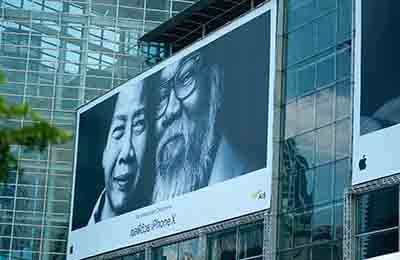广告英语语言特色
前言:本站为你精心整理了广告英语语言特色范文,希望能为你的创作提供参考价值,我们的客服老师可以帮助你提供个性化的参考范文,欢迎咨询。

摘要
广告,顾名思义就是广而告之。作为一种宣传和传播信息模式,广告的作用不容忽视,因为它不仅只是一种说服顾客进行消费的技巧,更重要的是,它已逐渐成为社会交流的必须手段之一。本文通过对大量英语广告实例进行分析,并参照国外著名广告人GuyCook等的理论,详细剖析了广告英语的语言特点。
广告在我们今天的社会几乎是无孔不入,它的传播介质多种多样,包括报纸、杂志、电视、广播、网络等。广告具有鲜明的目的性,即说服顾客进行购买,这种目的性决定了其语言的特色性风格,使其独立于其它文体,在语言学范畴内值得研究。本文选定英语这一全球普遍使用的语言,就其应用于广告领域而产生的一些语言学特点和广告本身的社会性特点进行深入分析,希望能对相关领域的研究有一定的借鉴作用和参考价值。
本文共分为五章,第一章追溯了广告的起源,对广告的分类、作用及定义做了简单概要;第二章介绍了广告和文体学的基本定义,广告中,文字和图像的完美结合取决于创意和所用媒体,但它们共同组成了广告语言;第三章从句法学、修辞学、词汇学等理论切入,用大量例子分析了广告英语的语言特点,并从语篇分析的角度对其语言特点进行了剖析;在语篇分析的章节中,引用了GuyCook的语篇分析模型,并引入了广告问题研究领域新近提出的“文章关联性”等概念;第四章结合了第三章的观点,通过具体英语广告实例对标题中的用词、句子结构、称谓模式、修辞格进行了阐述,分析了广告语言对广告效果的影响;最后一章指出了广告英语发展的口语化和简单化趋势及其目前存在的模糊性语言特点,揭开了广告华丽词藻下所掩盖的非真实的广告氛围,批判了其模糊性误导消费者的消极一面。
关键词:广告;广告英语;语言特点
Abstract
Asawayofpropagatingandtransmittinginformation,advertising’sroleconnotbeunderestimatedbecauseitisnotonlyanartfultechniqueinpersuadingpeopletobuy,butalsograduallyhasbecomeamustforsocialcommunicationwhichinturninfluencesthedevelopmentofsocietyandeconomy.ThepurposeofthispaperistostudythelinguisticfeaturesandsociologicalfeaturesofadvertisingEnglish,inthehopetohelpcopywritersathomemarketsintheircreatingprocess.
Nowadaysadvertisinghaspenetratedintoeverycornerofourlifeasitstransmittingmediainmanyforms:newspaper,magazine,TV,radioaswellasnetwork.Thegoalofadvertisingdecidesitslanguagetobesimpleanddirect,distinctfromthecharacteristicsofotherdiscourses.ThusananalysisonthelinguisticfeaturesofadvertisingEnglishinthelinguisticfieldisworthwhile.Undersuchcircumstances,astudyonthelinguisticfeaturesofadvertisingEnglishwillhavepracticaleffectsonthecomposingandtranslatingworkofthecopywriters.
Thewholepaperisdividedintofivechapters.Thefirstchaptertracesbacktheoriginofadvertisingandabriefintroductionontheclassifications,rolesanddefinitionsofadvertisingispresentedforthelaterdiscussion.
Thesecondchapterintroducesthetheoryofadvertisementsandstylistics,theprecisebalanceofwords(eitherspokenorwritten)andpicturesisdeterminedbythecreativeconceptandthemediumused,butthecombinationofimagesandwordsmakesupthelanguageofadvertising.
Thethirdchapterstartsfromthetheoriesinsyntax,lexicology,rhetoricandendswiththelinguisticfeaturesanalyzedinthefieldofdiscourseanalysis.
ThefourthchaptercombinestheviewpointsfromthepreviouschapterthirdandexplorestheeffectoftheadvertisingEnglishasawholeadvertisingprocess.Thelastchapter,alsotheconclusionpart,showsthatthoughadvertisinglanguageappearstobefloweryandrefined,itscontentisnobetterthancommonestlanguagecouldconvey.Byexposingthevarioustechniquesadvertisershaveemployedintheirwriting,thisparthopestoremindconsumersthatadvertisingEnglishisgraduallyattainingthenegativeandambiguousroleinguidingpeopletobuy.
Keywords:Advertising,AdvertisingEnglish,LinguisticFeatures
Chapter1Introduction
NootherstatementcouldhavesummedupthecharmofadvertisementthanwhatAldousHuxleyhascommented.Ashehassaidadvertisementasaliteraryformisthemostexciting,themostarduousliteraryformofall,andthemostpregnantincuriouspossibilities.Inhiscommentheassertedadvertisementisaliteraryformandthecopywritingprocessisthedelightfulandsalubriousexerciseforthemind.Butallinall,whatisadvertising,andwhatmakesitunique?
1.1HistoryofAdvertisement
Advertisementemergedfromthewombofcommodityproductionandexchange.Theconditionfortheexistenceofadvertisingis“atleastasegmentofthepopulationmustliveabovethesubsistencelevel”.Whenthissituationoccursitalsobecomesnecessaryfor“theproducersofmaterially‘unnecessary’goodstodosomethingtomakepeoplewanttoacquiretheircommodities.”(VestergaardandSchroder4)
Theembryonicformofadvertisingintheworldisstreetcries,whichexisteventoday.AdvertisingwasnotunknowninancientGreeceandRome,butadvertisingaswerecognizeitdidnotstartuntiltheseventeenthcenturyintheWest.Itwasataboutthistimethatnewspaperbegantocirculate.Beforethat,itisprintingwhichwasfirstinventedinChinaandthenintroducedtotheWestthatplayedavitalroleintheproductionofprintadvertising.“Classified”(smallads)typesofadvertisingweredominantbeforethenineteenthcenturyandstyleandlanguageusedinadsatthattimetendedtobedirectandinformative.TheindustrialRevolution,whichbeganinEnglandinthemid-1700sandreachedtheUnitedStatesbytheearly1800s,facilitatedmass-productionofgoods.Meanwhileadvertisingbecamemoreandmoreimportantintheindustrialmarket.Thegreatbreakthroughforadvertisingcameonlyinthelatenineteenthcentury.Technologyandmass-productiontechniqueswerethensufficientlydevelopedformorefirmstobeabletoturnoutproductsofroughlythesamequalityandatroughlythesameprice.Thisbroughtonacrisisofover-productionandunderconsumptionwhichmeantthatthemarketneededtobestimulatedbyadvertising.Atthistimeadvertisingchangeditsfunctionfromproclamationtopersuasion.Inthetwentiethcentury,advertisingdevelopedrapidlyalongsidetheadventofnewmedia-radioandtelevisioninsuccession.
AccordingtoRichardPollay’scontentanalysisoftwothousandprintadsfromtenleadingmagazinesintheUSA,adshaveprogressivelyturnedtowardstheemotionalratherthantheinformativeapproachandthereisashiftseeinghumannatureasrationaltoseemingitasemotional.
TodayinChina,whileoureconomicstructureisshiftingfromtheentirelyplannedeconomytothesocialistmarketeconomysystem,advertisingisbecomingmoreandmoreactiveandsophisticated.In1992,China’sadvertisingexpenditurereached$862million,amongthefastestgrowingcountriesinAsia.ThisyearwiththeentryofChinaintoWTO,thisexpenditurefigurewillundoubtedlyriseup,whichwillsupporttheviewthatadvertisingisanindispensablemeansforprovidingtheinformationthatallmarket-orientedindustrializedsocietiesneedfortheireconomiestofunctionefficiently.
1.2ClassificationsofAdvertising
Advertisingmaybeclassifiedbymedium(newspaper,magazine,radio,television).Bytargetaudience(consumer,industrial,business),bygeography(international,national,regional,local),orbyitsfunctionorpurpose(productornon-product,commercialornoncommercial,primarydemandorselectivedemand,directactionorindirectaction).
BecauseitisdifficulttogainaccesstoenoughdateforEnglishcommercialsandadsonradioorTV,thus,thesubjectofthisresearchpaperwillmainlyconcentrateontheprintadvertising.
1.3RolesofAdvertising
Anadvertiser’smainpurposeistopresentandexhibitproductorservice,andtospreadtheinfluenceandcoverageofwhichtotheextentthatthepotentialpurchasingpopulationbecomesrealandactual.Simplyput,advertiserstrybythevariousmeansattheirdisposaltogetpeopletobuytheproductorserviceadvertised.Moreover,advertiserswantpotentialpurchaserstoconsiderwhatisadvertisedtotheexclusionofallothersimilarproductsorservices.Theythereforeattempttoconstructanadvertisementthatwillfullyinvolvetheattentionofthepotentialpurchaserandwhichwillhaveapersuasiveeffect.Advertisersthuscreateasemioticworldinordertopersuadetheiraudienceofessential“rightness”ofpurchasingtheproductorserviceadvertised.
1.4DefinitionsofAdvertising
Afterabriefintroductionoftheclassificationsandrolesofadvertising,wenowcometothedefinitionsofadvertising.Fromdifferentperspectivesorpurposes,thedefinitionsmightalsovary.InEnglish,theword“advertise”hasitsoriginin“advertere”inLatin,meaning“toinformsomebodyofsomething”,“tobringintonotice”or“todrawattentiontosomething”,etc.InChinese,theequivalentterm“guanggao”means“widelyannounce”.
Thefatherofmodernadvertising,AlbertLaskersaidthatadvertisingwas“salesmanshipinprint”.Althoughthedefinitionwasgivenlongbeforetheadventofradioandtelevision,andthenatureandscopeofadvertisingatthattimewereconsiderablydifferentthantheyaretoday,thisoften-repeatedsayingindicatesthattheultimateobjectiveofadvertisingistosell.Obviouslyitisnotaworkingdefinitionbecausewecannotuseittocoveralladvertisements.Today,awidelyquotedworkingdefinitionofadvertisingwasputforwardbyCourtlandL.BoveeandWilliamF.Arens:”Advertisingisthenonpersonalcommunicationofinformation,usuallypaidforandusuallypersuasiveinnature,aboutproducts(goodsorservices)orideasbyidentifiedsponsorsthroughvariousmedia.”(Cook,Guy.TheDiscourseofAdvertising.London:Routledge,1992)
AnotherlinguistBolendefinesadvertisingasa“Paid,non-personalcommunicationthroughvariousmassmediabybusinessfirms,nonprofitorganizations,andindividualswhoareinsomewayidentifiedinthemessageandwhohopetoinformorpersuademembersofaparticularaudience.”(Carter,RonaldandGoddard,Angela,ReahDanutaetal.WorkingwithTexts.London:Routledge,1997)
Ifthedefinitionsofadvertisingweretoovagueandabstracttocomprehend,afewwordsofitsfunctionwouldhelptoclarifythiscrucialterm.Broadlyspeaking,advertisementshaveatleastoneoftwofunctions:informingorpersuading,althoughoverlapmayoftentakeplaceinonesinglepiece.Thetrickhereisthataninformativeadvertisementinforms“thecustomeraboutgoods,services,orideasandthentellshowtogetthemmeansofanidentifiedsponsor”(Bolen6).Examplesofinformativeadvertisementsarenotafew,rangingfromflyerstoinsertionsinmagazineandnewspapers,allofthataimtoadvertisenewproducts/servicesorspecialpricesoncertainproducts/services.Thistypeofadvertisementgivesbasic,factualinformationandsometimesshowsaphotosoranillustrationoftheproduct/servicetogivethetargetaudienceabetterviewabouttheadvertisedproduct.
Persuasiveadvertisementsarethustheinstrumentsusedbyadvertisers“whohavedefinedtheirtargetaudiencesanddeterminedtheeffecttheyhopetoachievethroughpersuasiveadvertisementsinthemedia”(Bolen9).Andapersuasiveadvertisementshouldtrytopersuadethepotentialcustomerstobuythenewproduct.(Bolen6)Thepersuasivefunctionisnotonlylimitedtoattractingthepotentialcustomerintobuyingacertainobject,butalsoincludingthesellingofservices,ideas,normsandvalues.
Tosummarize,wewouldgettheideathatfirstlyadvertisingisacommunicationprocess.Secondly,atleastamediumisused.Thirdly,thiscommunicationprocesshasadefinitepurposetoconvincethetargetaudience.Theabovethreecharacteristicssuggestadvertisingiscloselyconnectedwiththesociety,employingitsmedia,interconnectingwithitspeopleandguidingtheirbuyinghabit.Alsoinachievingtheadvertisingeffect,theadvertisinglanguageshouldbevividandattractive,whoselinguisticcharacteristicswouldbecoveredintheChapter3.
Chapter2TheoreticalBackground
.1Advertisement
2.1.1DefinitionandGoal
Advertisingisthepaid,impersonalcommunicationofinformationaboutproductsorideasbyanidentifiedsponsorthroughmassmediainanefforttopersuadeorinfluencebehavior.Notalladvertisingisalike.Advertisementsdifferdependingonwhothemessageisintendedfor,wheretheadvertisementisshown,whichmediaareused,andwhattheadvertiserwantstoaccomplish.(seeTable2.1)
Table2.1
Advertisingcanbeclassifiedinfourways:bytarget,geographicarea,mediaused,andpurpose.
ByTarget
ByGeographicArea
ByMediaUsed
ByPurpose
Audience
Consumer
Business:
Industrial
TradeProfessional
Agriculture
International
National
Regional
Local
Print:
Newspaper
Magazine
Electronic:
Radio
Television
Internet
Out-of-home:
Outdoor
Transit
Directmail
Directories
Othermedia
Productiveornonproductive
Commercialornoncommercial
Primarydemandorselectivedemand
Directactionorindirectaction
Thepurposeofcopywritingistopersuadeorremindpeopletotakesomeactiontosatisfyaneedorwant.Butfirstpeopleneedtobemadeawareoftheproblemor,iftheproblemisobvious,ofasolution.Tocreateawareness,thecopywritermustfirstgetpeople’sattention—forexample,byusinglargetypeandprovocativevisuals.Next,thecopywritermuststimulatetheprospect’sinterestintheproductandbuildcredibilityfortheproductclaims.Thenthecopywriterfocusesongeneratingdesireandfinallyonstimulatingaction.Thesefiveaspectsshouldbepresentineveryadvertisementorcommercial.
Hereistheadvertisingpyramid.
2.1.2ElementsofanAdvertisement
Asonewillsee,anyadvertisementismadeupofseveralelements.Mostadvertisementsusedallofthem.Theyincludetheheadlineordisplayline;theillustration;thebodycopyortext;thethemelineorslogan,tradecharacter,seal,andothermarks;andthelogotypeorsignature.Eachwillbeconsideredinsomedetailbelow.
(1)Headlines
Theheadlineordisplaylineappearsinmostadvertisementsforseveralreasons.First,itisanattention-gettingdevice;secondly,italsoselectsanaudiencebyappealingtoaspecificgroup,asthislinedose:Arthriticsreducepainfulinflammationandgetstomachupsetprotection.(Anadformedicine)Finally,itisthekeyfactoringettingpeopletoreadthebodycopy.
(2)Illustration
Inadditiontoheadlines,mostadvertisementscontainillustrations.Theillustrationliketheheadline,attractsattention,selectstheaudience,andstimulatesinterestinbodycopy.Whatismore,theillustrationcanbeinvaluableinshowingtheproductorproductuseandexplaininggraphicallycertainideasorsituationsthatarecumbersometoputintowords.Theoldsayingthatonepictureisworthathousandwordshasmuchmeritinit.
(3)BodyCopy
Tobeginwith,someexplanationofthewordcopyisnecessary.Thejobofbodycopyistostimulateinterestintheproductorserviceorideabeingadvertised,createsdesireforit,andurgeaction.Thisisabigtaskandcallsforrightwords.Althoughheadlinesandillustrationscleartheway,itisbodycopythatmustcarrytheburdenofthesellingjob.
(4)Themelines,slogan,tradecharacters,sealandothermarks
Anumberofdifferentmarksanddevicesmayappearinanadvertisement,includingthemelines,tradecharacters,andseals;Forexample,GeneralFoodsusesthecorporateidentitysymbolinallitsadvertisements.Theautomaticuseoftheseelementsintheadvertisement,however,doesnotdiminishtheirimportance.
2.2Stylistics
2.2.1TheNeedforStylistics
WhentalkingabouttheEnglishlanguage,oneshouldnotbemisledintothinkingthatthelabelshouldinsomewayrefertoareadilyidentifiableobjectinreality,whichhecanisolateandexamineinaclassroomasatest-tubemixture,apieceofrockorapoem.ThelabeloftheEnglishlanguageisinfactacomplexofmanydifferent‘varieties’oflanguageinuseinallkindsofsituationsinmanypartsoftheworld.Naturally,allthesevarietieshavemuchmoreincommonthandifferentiatesthem-theyareallclearlyvarietiesofonelanguage,English.Butatthesametime,eachvarietyisdefinablydistinctfromalltheothers.
AsaneducatedspeakerofEnglish,astudentofEnglishis,inasense,multilingual:forinthecourseofdevelopinghiscommandoflanguage,hehasencounteredalargenumberofvarieties,andtocertainextent,haslearnednowtousethem.Aparticularsocialsituationmakeshimrespondwithanappropriatevarietyoflanguage,thelanguageofconversation,thelanguageofnewspaperreporting,thelanguageofadvertisingandsoon.Butwhatisstylistics?
2.2.2Definition
Inthepast,menhavebeenintriguedwithstyleandmanystudentsofhumancommunicationhaveofferedtheirideasaboutit.Someareconcernedwithclarity-orlucidity,asAristotlecalledit.ForthisancientGreekcritic,itwasimportantthatthespeakerorwriternotonlyhasideasbutthathesaysthem‘intherightway’,awayanaudiencecanunderstandclearly.Healsosaidthatstyleshouldbeneitherabovenorbelowthedignityofthesubjectbutmustbe‘appropriate’.Anotherstudentoflanguageandhumanuseofit,theScottishwriterGeorgeCampbell,alsobelievedwords(theauthor’sdictionorwordchoice)werethefoundationofstyle.Hebelievedthebeststylecomesfromdictionthatthelistenernoticessolittlethatheisbarely‘consciousthatitisthroughthismediumdictionheseesintothespeaker’sthoughts’(ThesenseofstylebyGeoffreyN.Leech).Butunfortunately,theydonotclarifymattersgreatly,atleastfourcommonlyoccurringsensesofthetermstyleneedtobedistinguished.
Stylemayrefertosomeorallofthelanguagehabitsofoneperson-aswhenpeopletalkofShakespeare’sstyle(orstyles),orthestyleofJamesJoyce.Moreoften,itreferstoaselectionoflanguagehabits,sharedbyagroupofpeopleatonetime,oroveraperiodoftime,aswhenwetalkaboutthestyleoftheAugustanpoets,thestyleofOldEnglish‘heroic’poetry,thestyleinwhichcivilservicesformsarewritten,orstylesofpublic-speaking.
Styleisgivenamorerestrictedmeaningwhenitisusedinanevaluativesense,referringtotheeffectivenessofamodeofexpression.Thisisimpliedbysuchpopulardefinitionsofstyleas‘sayingtherightthinginthemosteffectiveway’oras‘goodmanners’.(InvestingEnglishstylebyDavidCrystal&DerekDavy)
Partlyoverlappingwiththethreesensesjustoutlinedisthewidespreaduseofthewordstyletorefersolelytoliterarylanguage.Stylehaslongbeenassociatedprimarilyorexclusivelywithliterature,asacharacterized‘good’,‘effective’,or‘beautiful’writing.
Oftheabovefoursenses,thefirstandsecondcomenearesttowhatismeantbystyle.Asastarting-point,theaimofstylisticsistoanalyzelanguagehabitswiththemainpurposeofidentifyingfromthegeneralmassoflinguisticfeaturescommontoEnglishasusedoneveryconceivableoccasion.Thosefeatureswhicharerestrictedtocertainkindsofsocialcontextaretoexplain,wherepossible,whysuchfeatureshavebeenused,asopposedtootheralternatives,andtoclassifythesefeaturesintocategoriesbaseduponaviewoftheirfunctioninthesocialcontext.
免责声明:以上文章内容均来源于本站老师原创或网友上传,不代表本站观点,与本站立场无关,仅供学习和参考。本站不是任何杂志的官方网站,直投稿件和出版请联系出版社。



